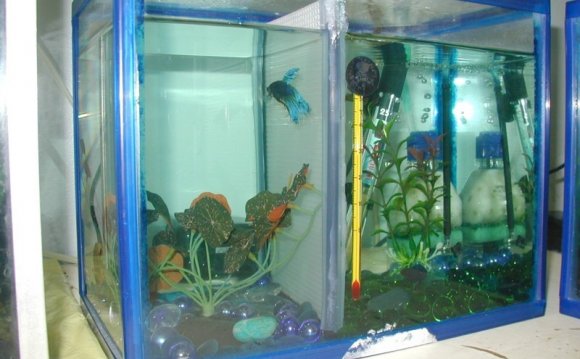
 The betta, also known as the Siamese fighting fish, has become a popular fish among hobbyists primarily because of the male’s beautiful colors and lavish finnage. More than one female can be kept in a peaceful community setting, as long as there are no fin-nipping fishes, such as some of the characins and barbs.
The betta, also known as the Siamese fighting fish, has become a popular fish among hobbyists primarily because of the male’s beautiful colors and lavish finnage. More than one female can be kept in a peaceful community setting, as long as there are no fin-nipping fishes, such as some of the characins and barbs.
The male betta, however, should either be housed in a 1-gallon or more container as a single specimen or as the only male of its species in a peaceful community tank setting. Otherwise, the male will attack and tear other the fins of other male bettas, sometimes resulting in the death of one of the combatants.
A female and a male should only be kept together if baby bettas are desired. The male will harass the female before, during and after spawning, and, unless sufficient hiding places are provided, may even kill her.
The betta can be housed in an aquarium that is moderately decorated with plants, rockwork and driftwood. Avoid any decorations or gravel with sharp edges. Plants should be kept to the sides and back of the tank, as well as a few of the floating varieties at the surface. This fish is an excellent jumper, so a tight-fitting cover is a must.
If you are housing a single male in a gallon container, the surface must be kept free of dirt and debris. Frequent water changes are a must in this situation.
The betta will accept a wide variety of foods, including small live foods, such as bloodworms, black worms, chopped earthworms, Tubifex worms, glass worms and brine shrimp. It will also accept flake and freeze-dried foods, including the specialized betta diets now available at pet stores.
If you decide to breed your bettas, it is best to house a breeding pair in a separate tank and disconnect any filters or aeration devices that may destroy the bubble-nest. Once courting has begun, the male will build a bubble-nest among the leaves of the floating plants. Male and female will “intertwine” and the eggs will fall onto the anal fin of the male. He will disengage from the female and the eggs will begin to fall through the water.
The male gathers the falling eggs in his mouth, coats them with saliva and carefully “spits” them into the bubble-nest. The female will also participate in placing the eggs in the nest, but soon the male will chase her away and care for the brood himself. At this time it is important to remove the female or the male will do her serious harm. Once the fry are free swimming, in about five days, the male should also be removed.









